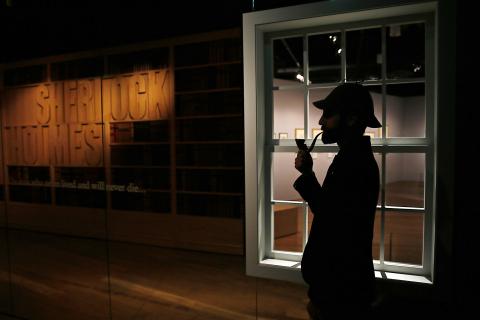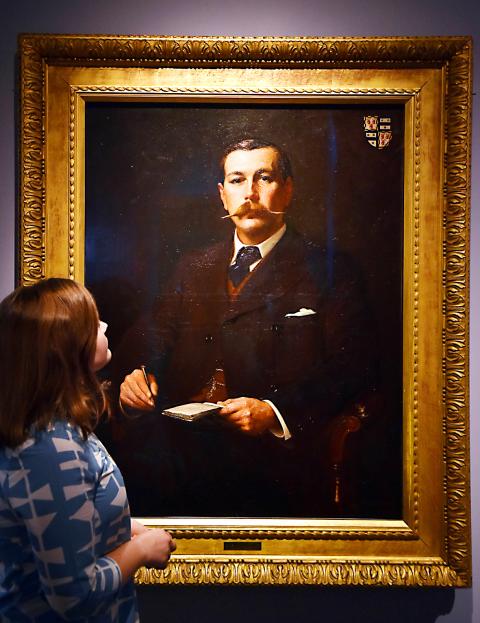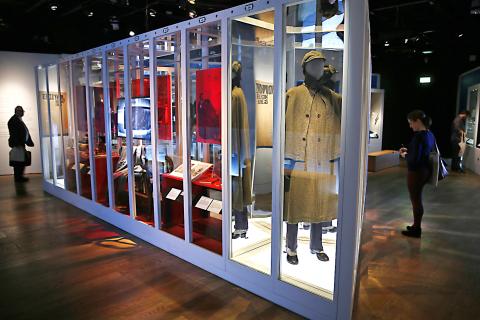A riveting exhibition here at the Museum of London has capitalized on the full-blown Sherlockmania that seems to have seized the Western world, judging by a new spate of movies, television shows and books.
Unexpectedly, the show, Sherlock Holmes: The Man Who Never Lived and Will Never Die, which has drawn record numbers to the museum and continues until April 12, does not focus on the stories about Holmes or his creator, Arthur Conan Doyle, though an opening section shows some early notebooks and illustrations as well as a rare portrait of the author in his 30s.
“We deliberately didn’t want to make it a text and manuscript-heavy library exhibition,” said Alex Werner, the lead curator. “It’s about the character, and although I had a bit of trepidation about putting on an exhibition about a fictional being, we tried to set him firmly against the real city of London in which the stories take place.”

Photo: REUTERS
Divided into five parts, the exhibition neatly demonstrates the way Sherlock Holmes has become entwined with an idea of the city itself. From the detective’s consulting rooms at 221B Baker Street to the mental map of the city that Holmes keeps in his head and its foggy, gaslamp-lighted streets, London is a palpable character in the exhibition, evoked through a fascinating collection of paintings, postcards, maps, photographs and archival films.
Monet’s 1902 Pont de Londres (Charing Cross Bridge, London) is on display in the show, as are a number of Whistler prints and other painterly evocations of the late-19th-century city, and a superb collection of smoky photogravures by the American photographer Alvin Langdon Coburn.
For Holmes aficionados, there are also rarely seen original illustrations by Sidney Paget, who gave the character the angular features and deerstalker cap, now familiar, in the early stories published in The Strand Magazine that first made Conan Doyle and his characters famous. Paget produced some 350 illustrations of the detective between 1891 and 1904, but only 27 are known to have survived. Eight are on view in the exhibition.

Photo: AFP
“I doubt very much there will ever be so many original illustrations and documents together again,” said Roger Johnson, the editor of The Sherlock Holmes Journal for the Sherlock Holmes Society of London, a club founded in 1951 that now has 1,200 members worldwide.
Conan Doyle, whose first Sherlock Holmes story, A Study in Scarlet, was published in 1887, was amazed (and slightly exasperated) by the success of his literary creation. He might be even more surprised by the renewed attention to his famed character.
There is Mr Holmes, which had its premiere at the Berlin International Film Festival on Sunday and stars Ian McKellen as the detective, now elderly; the recent pair of Sherlock Holmes movies starring Robert Downey Jr and Jude Law (as Doctor Watson); and two television series — the BBC’s Sherlock and CBS’ Elementary — that set Holmes and Watson in a contemporary context. (An eagerly anticipated special episode of Sherlock is now in production.)

Photo: REUTERS
Together with a coming festival of silent Sherlock films at the Barbican here, and the constant stream of books that update and rework the original stories and their characters, the Sherlock phenomenon seems as vigorous as ever.
“The fascination with him today is really a bit special,” Werner said. “There are parallels between our modern lives and late-19th-century London, when I think people were struggling to make sense of a changing world. There was the telegraph, films, life was speeding up, and I think we have a similar thing going on now. We have too much to assimilate, and here you have a character who can see through things more clearly than we can.”
Anthony Horowitz, who was given official sanction by the Conan Doyle Estate to write a new Holmes novel, The House of Silk (2011), and whose Moriarty was published in December, said he thought that Sherlock Holmes was the father of all modern detective fiction.
“Every single detective story you read has the same structure: mystery, investigation, solution. And the tradition of the detective’s sidekick comes from there — Poirot has Hastings, Morse has Lewis,” he said, referring to the well-known characters in novels by Agatha Christie and Colin Dexter.
“He also embodies an idea of Englishness,” Horowitz added. “If you were to ask for 10 things that define this country, I’d say Sherlock Holmes is one of them.” (Some others? “The queen, Yorkshire pudding, marmalade,” Horowitz answered promptly.)
Conan Doyle wrote four Sherlock Holmes novels and 56 short stories about the detective between 1887 and 1927, and they have provided material for radio personalities, directors, writers and obsessed fans ever since. (They have also been fodder for lawsuits and fevered debate over the estate’s demand that licensing fees be paid for any use of the character in any medium.)
There are numerous online fan clubs, as well as other associations, like the Baker Street Irregulars, founded in 1934, and the more recent women-only association, the Baker Street Babes. Membership, Johnson said, had been greatly bolstered in recent years by the Sherlock television series.
“We used to have the Brett brats, and now we’ve got the Cumberbunnies,” he said, referring to fans of the 1980s Sherlock Holmes television series starring Jeremy Brett and the current series featuring Benedict Cumberbatch (with Martin Freeman as Watson). “We’ve got members in their 20s and 30s, even a few in their teens. They start by thinking the show is wonderful, then they read the books.”
Speaking on the telephone during a break while filming the special episode of Sherlock, Mark Gatiss, who created the series with Steven Moffat, said Conan Doyle had given Sherlock one crucial characteristic.
“He has an achievable superpower,” he said. “You read it or watch it, and you think, ‘Maybe I could be as clever as Sherlock Holmes.’”

On April 26, The Lancet published a letter from two doctors at Taichung-based China Medical University Hospital (CMUH) warning that “Taiwan’s Health Care System is on the Brink of Collapse.” The authors said that “Years of policy inaction and mismanagement of resources have led to the National Health Insurance system operating under unsustainable conditions.” The pushback was immediate. Errors in the paper were quickly identified and publicized, to discredit the authors (the hospital apologized). CNA reported that CMUH said the letter described Taiwan in 2021 as having 62 nurses per 10,000 people, when the correct number was 78 nurses per 10,000

May 5 to May 11 What started out as friction between Taiwanese students at Taichung First High School and a Japanese head cook escalated dramatically over the first two weeks of May 1927. It began on April 30 when the cook’s wife knew that lotus starch used in that night’s dinner had rat feces in it, but failed to inform staff until the meal was already prepared. The students believed that her silence was intentional, and filed a complaint. The school’s Japanese administrators sided with the cook’s family, dismissing the students as troublemakers and clamping down on their freedoms — with

As Donald Trump’s executive order in March led to the shuttering of Voice of America (VOA) — the global broadcaster whose roots date back to the fight against Nazi propaganda — he quickly attracted support from figures not used to aligning themselves with any US administration. Trump had ordered the US Agency for Global Media, the federal agency that funds VOA and other groups promoting independent journalism overseas, to be “eliminated to the maximum extent consistent with applicable law.” The decision suddenly halted programming in 49 languages to more than 425 million people. In Moscow, Margarita Simonyan, the hardline editor-in-chief of the

Six weeks before I embarked on a research mission in Kyoto, I was sitting alone at a bar counter in Melbourne. Next to me, a woman was bragging loudly to a friend: She, too, was heading to Kyoto, I quickly discerned. Except her trip was in four months. And she’d just pulled an all-nighter booking restaurant reservations. As I snooped on the conversation, I broke out in a sweat, panicking because I’d yet to secure a single table. Then I remembered: Eating well in Japan is absolutely not something to lose sleep over. It’s true that the best-known institutions book up faster